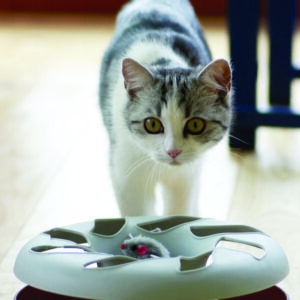By Dr. Beth Leermakers
Is your cat getting enough exercise? Regular physical activity is essential to help your kitty maintain a healthy weight and prevent depression, boredom and destructive behavior. A friend’s indoor/outdoor cat recently racked up thousands of dollars in vet bills after being hit by a car. The adventurous cat’s outdoor explorations are now limited to leash walks using a harness. When I asked how those walks were going, my friend grimaced. Apparently, leash training is a slow process.

Photo courtesy of Pinterest
If walking your cat doesn’t sound like fun, you can build more activity into his normal routine and play with him instead. Set aside time every day to play. Play sessions should be about 10-15 minutes each and can range from two to three daily sessions for older cats to up to 10 sessions for kittens and younger cats. Cats are most active at dawn and dusk, so they may be most interested in playing in the early morning or evening.
Here are a few simple ways to get your cat moving:
Let Kitty Work for His Meals
Cats in the wild spend at least 30 percent of their time hunting for their next meal. We deprive them of physical and mental stimulation by putting their food in a bowl in the kitchen. Instead, we need to give cats a way to work for their supper:
Move the food bowl to an out-of-the-way location so your cat has to walk farther to dine. Or scatter small amounts of kibble — or place small bowls of canned food — in various locations throughout your house. If possible, put Fluffy’s food upstairs for an even better workout.
Use a food puzzle
Interactive, food-dispensing toys provide exercise and mental stimulation and satisfy a cat’s urge to hunt. Fill the Kong Active Treat Ball Cat Toy with kibble and let the good times roll. This toy’s unpredictable movement creates a new experience every time. This is a great toy for your cat to play with when she’s alone.
Make a piñata
Cats love to bat things that hang overhead — especially when there’s food involved. To make a piñata, cut a small hole in the bottom of a plastic container (e.g. a yogurt or sour cream cup) with a lid. Put treats or kibble inside and hang the pinata where your cat can reach it. When she hits it the right way, the treats will fall out.
You’re probably familiar with popular cat toys such as wands/fishing poles, catnip mice and laser pointers. Bubbles (including catnip-infused ones) are great fun to chase and pop. Catios — enclosed outdoor environments — allow your cat to watch birds and explore the outdoors, get some activity, and stay safe from predators and cars. Household items make engaging toys. Large cardboard boxes, with kibble or leaves on the bottom, are highly entertaining. Make tunnels out of paper bags with the bottoms cut off, or put treats in several bags for an instant treasure hunt. Be sure to cut the handles off the bags for safety. Turn paper towel or toilet paper rolls into food puzzles by stapling the ends and cutting holes in the tubes. Ping pong balls are a great size for cats — too big to be a choking hazard.
Create a hockey rink
Put a ping pong ball in a large cardboard box or the bathtub to make an instant “hockey rink.” You’ll laugh as your cat careens around the rink in pursuit of the ball, and your cat will get some much-needed exercise.
Build an agility course
If your cat is extremely energetic and agile, try some cat agility exercises. Your course can include several obstacles, such as bars to jump over or tunnels to pass through, which push your cat both physically and mentally. For inspiration, search for cat agility courses online.
Take a Walk
With the right training and equipment, you’ll be able to venture outside. Neighborhood walks are best suited for cats who aren’t shy/easily spooked. Young cats are easier to train, but you’ll need patience and perseverance for any cat.
There’s a reason we say “it’s like herding cats.”
Use a harness instead of just a collar for leash walks. Make sure the harness fits properly so your kitty can’t wriggle out of it. Start by having her wear the harness around the house for a few minutes, gradually increasing the time. Give her a treat when you put it on. Then attach the leash and let her drag it around the house. Then pick up the leash and put a little pressure on it. Use plenty of treats throughout the process.
Some cats may take to the leash immediately, while others may need a week or two to get comfortable with it. Be sure your cat is microchipped and wearing an ID tag, in case she gets away from you on your walk.
Playing with your cat is good for your mental and physical health too, relieving stress and reducing blood pressure. Have fun with your cat! If you manage to walk your favorite feline on a leash, please send me a photo.
